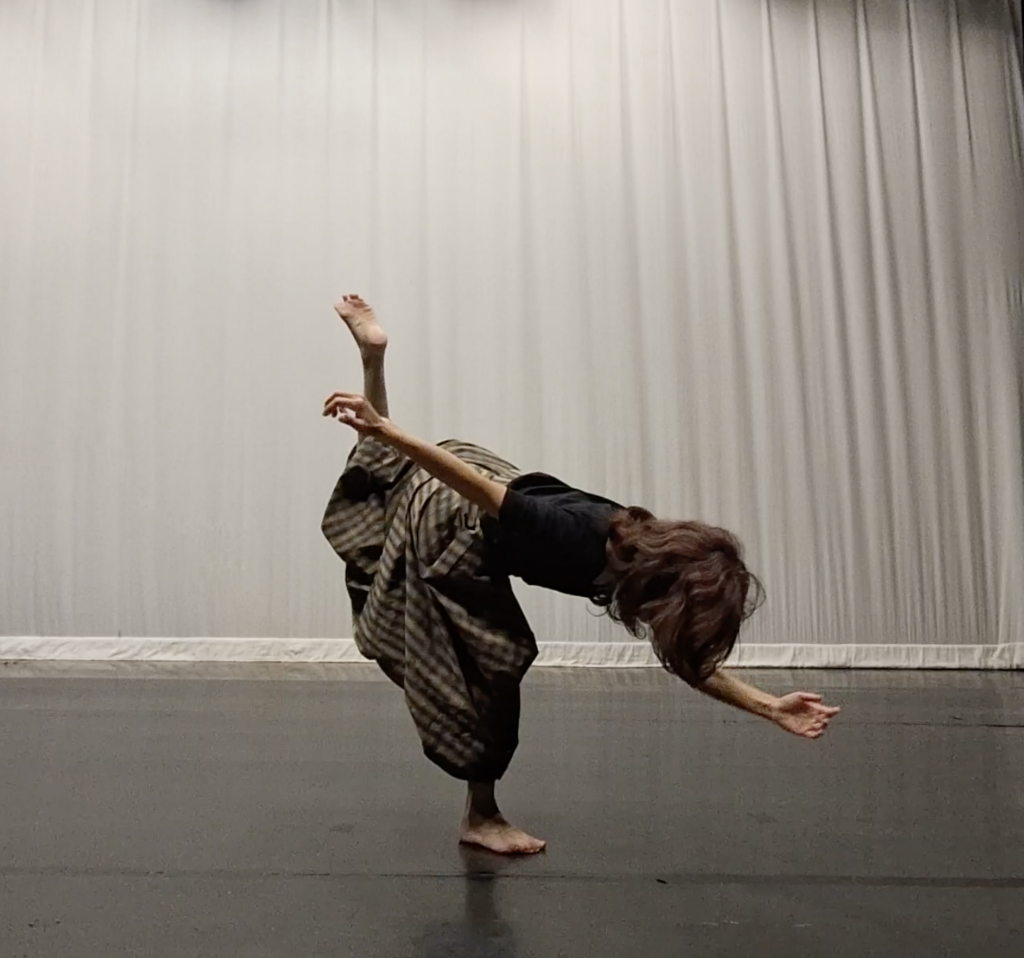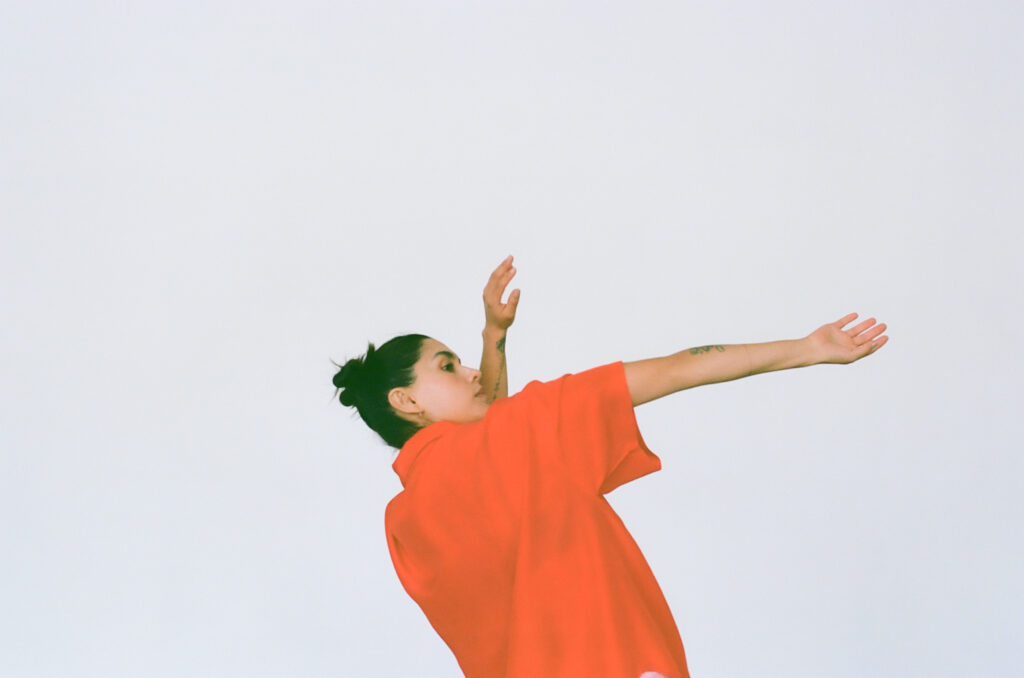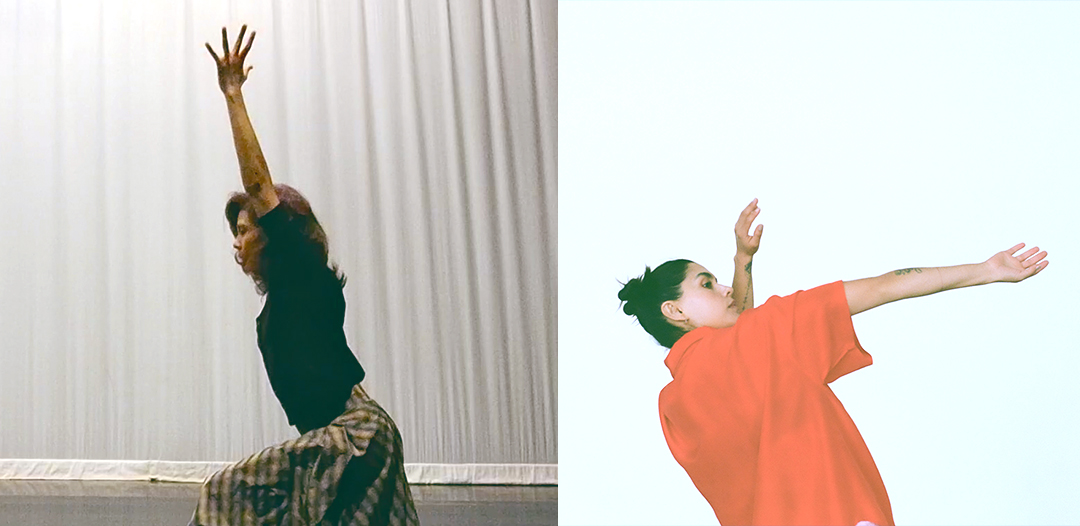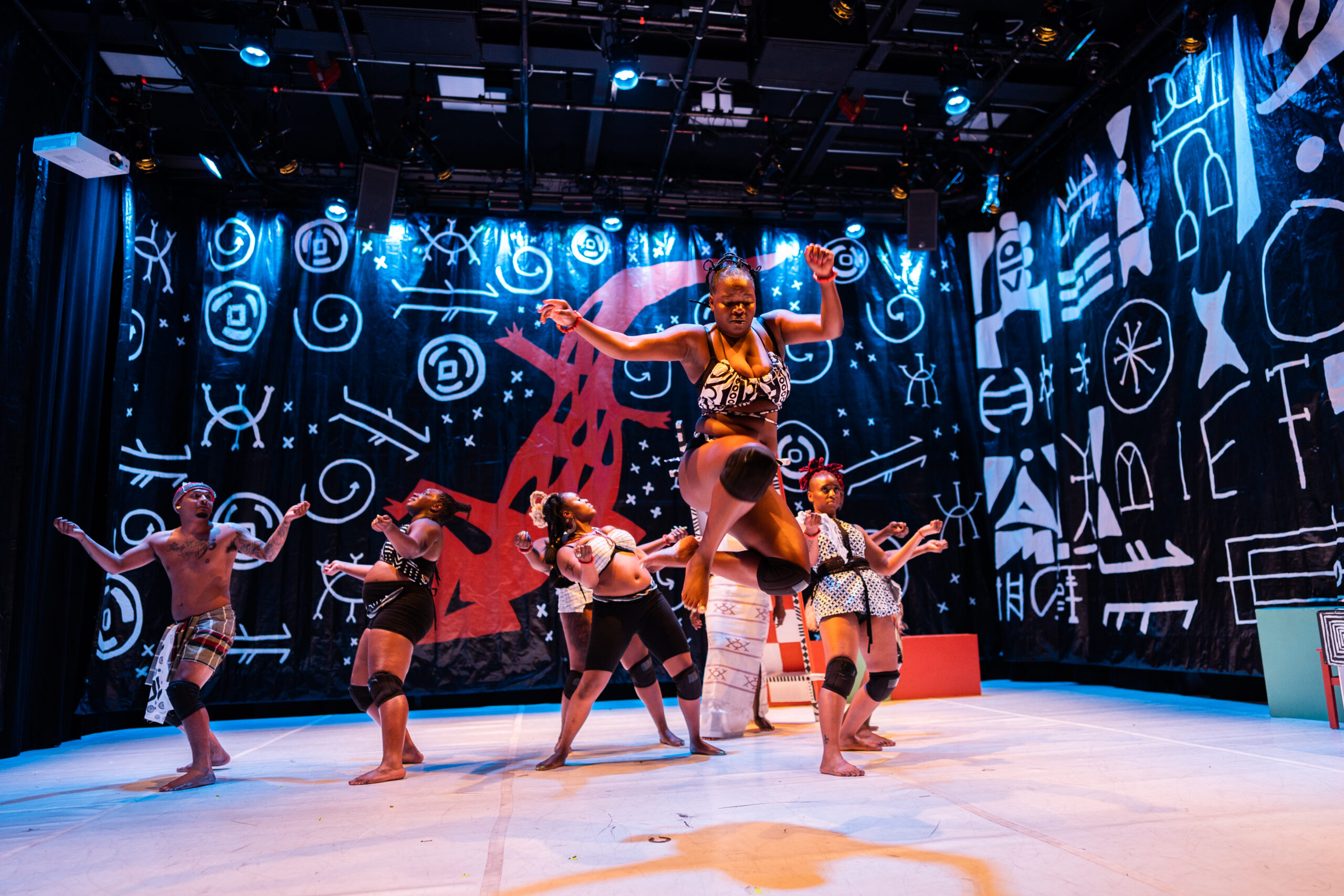I Savia~Sap flow: Embodied Connection with Ancestry and Nature by Diana Lara &
auiga by gizeh muñiz vengel in collaboration with Grisel Torres and Ernesto Peart Falcón
June 6-8 & 13-15, 2024 // 80 Turk St, SF
Live Audio Description and Haptic Access Tour on Saturday June 15th by Gabriele Christian of Gravity Access Services for visually impaired audience members. Haptic Access Tour begins at 1PM Please call 415-626-2060 to pre-register and reserve a headset.
SAN FRANCISCO, CA — CounterPulse’s 2024 Edge program presents Sap Flow: Embodied Connection with Ancestry and Nature by Diana Lara and auiga by gizeh muñiz vengel. Savia~Sap flow: Embodied Connection with Ancestry and Nature explores the sap flow in trees as a metaphorical representation of the interconnectedness between human fluids, nature, and ancestral heritage. By embodying the qualities of these fluids, the artists intend to establish a direct connection with their Lenca indigenous ancestors. auiga is a poem that contains us to daydream together.
Counterpulse’s Artist Residency & Commissioning (ARC) Edge ProgramEdge is an incubation residency and commissioning program for contemporary choreographers whose work is deeply curious about the intersection of art practice and social change. Through work-in-progressing showings, discourse events, and culminating live performances, this program is a platform for investigating relevancy and creating new knowledge. By eliminating boundaries between disciplines, between artists and audience, and between communities, Edge produces innovative performance works with transformational potential.
Savia~Sap flow: Embodied Connection with Ancestry and Nature
by Diana Lara

Savia~Sap flow: Embodied Connection with Ancestry and Nature explores the pathway, rhythm, and characteristics of the sap flow within trees, drawing inspiration from the concept of embodying fluids from Body Mind Centering® practice. The project seeks to investigate the sap flow in trees as a metaphorical representation of the interconnectedness between humans, nature, and ancestral heritage. By embodying the qualities of this fluid, the artists intend to establish a direct connection with their Lenca indigenous ancestors. Four artists involved in this project are from Honduras, and have Lenca ancestry. The possibility of creating this liquid connection —human-to-tree—might offer a way to contest racist and oppressive systems ingrained in family and socio-economic structures that have been perpetuated by colonial legacies and cultural influences from the United States. The project aims to motivate others to reclaim all their ancestry, all their roots without hierarchies, facilitating a collective journey of self-discovery and healing.
Diana and collaborator, Isadora share about the process of this upcoming work and thoughts on creating alongside Lenca traditions.
They write “Who we are is essentially linked to the space in which we grew up and all the memories we have about those spaces. When we talk about the space where we grew up, we include the space of the maternal womb, the spatial configuration of embryological development, the coordinated and precise movement of cells that originates human tissues and systems.”
Read more at In Dance: Mujer Sav/bia*, Guatesi torta Yalabitata** by Diana and Isadora
About the Artists
Diana Lara (she/her) a choreographer, performer, and somatic movement educator born and raised in Honduras. Her choreographic work is influenced by contemporary dance, contact improvisation, Body-Mind Centering training, and Latinx culture. She creates choreographies that explore the effects of coloniality, religion, and gender on the body, and that generate rituals to peel layers of oppression. She is nurtured and committed to create work in collaboration with artists from different disciplines, and to generate containers that allow us to value and enjoy the creative process. Her choreographies have been staged in San Francisco Bay Area venues including the Mission Cultural Center for Latino Arts, NohSpace, Dance Mission Theater, Moments Notice, Counterpulse 2nd Sundays, The Garage, and Safe House Arts; and in Mexico City, Canada, and Honduras venues.
Main Collaborators:
Gabriel Vallecillo Márquez multidisciplinary artist. He started as a poet then moved onto video-poetry, video-jockey, 3d projection mapping, live cinema, video and VR installation, documentary film and video performance. His video art installations have been featured at Biennials in Ecuador, Panamá, Nicaragua and Honduras. His artworks have also been exhibited in Cuba, Italy, USA and Germany. Gabriel is currently based in Berlin. www.gabrielvallecillo.com / https://liminal-space.art/.
Isadora Paz Taboada (she/her) is a Honduran-Argentinian dance artist, leader and co-founder of DA escenica, an independent collaborative project based in Tegucigalpa, Honduras. She has been a resident artist at ADF Durham, NC and the National Choreographic Center in La Rochelle, France. She explores community narratives, practices and performances promoting collective inquiry and intercultural dialogue through dance and performance. https://www.facebook.com/daescenica/about
Performers:
Olivia Treviño (she/her) is a second and seventh generation Mexican-American of Indigenous (Chichimeca) and Spanish descent. She is a theatre artist, dancer, community organizer, activist, educator and drama therapist who places decolonization, ancestral connection and liberation at the center of her personal and professional practices. Olivia taught acting, improvisation and movement at Saddleback College in Mission Viejo from 2013-2017, has been a recurring guest teaching artist at Cal State University Long Beach, as well as assistant directed at South Coast Repertory, UCLA, Juilliard and Cal Rep. She holds a BA in Theatre in Acting and Directing from Cal State Long Beach and a MA in Counseling Psychology in Drama Therapy from California Institute of Integral Studies.
Ronice Lindsey is a dance artist living on Ohlone land in Oakland, CA. Dance has become her highest expression—releasing what she holds within, in connection with others and the Earth that holds her. Part of that work includes Ro’s continued exploration of her Honduran identity, digging up its pain and joy, finding lost lines through her dance. Ronice is currently a company artist with Dancing Earth–a BIPOC dance company centering humans’ connection with ecology, led by the artist director Rulan Tangen. They debuted the production “Eco Elegies – Ritual of Re:Mix” in September 2023 in Yelamu (SF) at the Dance Mission Theater and had community performances of the work at SNAG Magazine’s anniversary celebration and the multicultural Mosaic Festival in San Jose. Ronice will partake in the company’s teacher training and artivist program in 2024, which includes a tour in Mexico.
auiga
By gizeh muñiz vengel

auiga
As we intend to create a new way of being with each other, we call ourselves into the vital presence of the world and into a deep and attentive presence with one another
We rest and stay quiet to listen
Speaking in movement and rhythm,we vocalize a language that praises the long tides of the ocean, and polyrhythmic pulse of this place
We wonder
Our breathing bodies yield to gravity as a stuttering desire to feel the mutual attraction between our bodies and the land
We arrive
This piece is a poem that contains us to daydream together.
Take a look into gizeh’s moodboard for this upcoming performance!
gizeh muñiz vengel
Mexicana. Movement, Teaching and Performing artist based in Chochenyo Ohlone Land.
They are devoted to the study of being a body through movement and stillness while creating creative strategies for building warmer relationships with others, and recognizing the sovereignty and personhood of the land, the waters and other beings who we coexist with.
Their dance lineage follows the work of Kathleen Hermesdorf, Sara Shelton Mann and her somatic and Biodynamic Craniosacral Therapy studies, as well as her ten year dance studies in different parts of Mexico, with teachers like Ángel Arámbula, Briseida López, Octavio Dagnino, Ilse Meza and Humberto Vega, among many many others amazing Mexican artists.
She has performed as a dancer and creative collaborator with NAKA Dance Theater, Kinetech Arts, estrellx supernova, Sara Shelton Mann, Larry Arrington, Kathleen Hermesdorf and Lizz Roman in the Bay Area; Silla Danza, Lux Boreal and Jess Humphrey in Tijuana/San Diego and Ocho Proyecto Gato in Mexico City to mention some.
gizeh is curator and producer of KH FRESH Festival, Performance Primers and Gatherings class series in the Bay Area, California.
They are currently an artist in residency at
Counterpulse @counterpulse and in The Community Engagement Residency with Bridge Live Arts, and the 2023-2024 RAW Fellowship recipient.
grisel gg torres
GG / grisel torres is a mexican artist that has resided on Ohlone Lands all of their life. this person loves to create art around the people they love. time, earth, water, air, and the sun are consistent inspirations for GG in their paintings, lighting compositions, soundscapes, and hand made objects. you can find GG working at CounterPulse in SF’s Tenderloin neighborhood as the producing technical director.
Ernesto Peart Falcón
Contemporary dancer and performer originally from Saltillo, México.
Interested in the search for new forms and ways of expressing.His work focuses on movement research and collaboration.
He has collaborated as a dancer and performer with international choreographers and groups like Damien Jalet (Belgium), Kaori Seki (Japan) Martha Hincapié (Germany), Vladimir Rodríguez (Colombia), Gilberto González (México) y Leandro Kess (Argentina) amongst others. He graduated from the Mazatlan Professional School of Dance in 2011 and has worked with companies such as Delfos Danza and CEPRODAC touring in America, South America, Europe and Asia.
About CounterPulse
CounterPulse is building a movement of risk-taking art that shatters assumptions and builds community. We provide space and resources for emerging artists and cultural innovators, serving as an incubator for the creation of socially relevant, community-based art and culture. CounterPulse acts as a catalyst for art and action; creating a forum for the open exchange of art and ideas, catalyzing transformation in our communities and our society. We work towards a world that celebrates diversity of race, class, cultural heritage, artistic expression, ability, gender identity, and sexual orientation. We strive to create an environment that is physically and economically accessible to everyone. Counterpulse.org
CounterPulse’s ARC Edge residency program is made possible with support from the Ken Hempel Fund for the Arts and the National Endowment for the Arts.
Photo Credit:
Header Left Image: Photo by Diana Lara Alt text: A light brown woman wearing a big brown skirt and a black blouse with her brown hair covering her face. She is standing on right leg with her torso and head forward, her left leg is lifted behind, her left arm is in front and right arm is behind, arms are soft and reaching in space. She is standing on black floor with a white curtain background.
Header Right Image: gizeh muñiz vengel by Robbie Sweeny Alt text: Photo of a wide landscape of Uyuni Salt Flats in Bolivia. The sky looks white and light blue, and it is reflected on the water like a mirror effect
Share This!
More Good Stuff
Edge is an incubation residency and commissioning program for contemporary choreographers whose work is deeply curious about the intersection of art practice and social change.
Inspired by ancestral, community-centered, and spiritual relationships to land and plants, [and then we must be] by Audrey Johnson is a research and ritual project honoring Black American practices with land and plants through the modes of food, farming, rootwork, and magic. The work honors the practices that get passed down through recipe, spell, and story, as well as the memories active and activated in the body, plants, the land (soil, clay, mycelium, strata), and in spirit.
"Traditionally, in Igbo cultures, we have had death as part of the conversation. We understand that life doesn't end when you die. Ancestors are part of our life connection and day-to-day practice."




